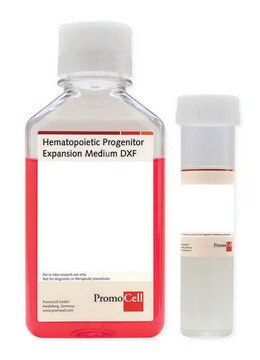04-822
Anti-Rho (-A, -B, -C) Antibody, clone 3L74, rabbit monoclonal
culture supernatant, clone 3L74, Upstate®
Synonym(s):
ras homolog
Sign Into View Organizational & Contract Pricing
All Photos(1)
About This Item
UNSPSC Code:
12352203
eCl@ss:
32160702
NACRES:
NA.41
Recommended Products
biological source
rabbit
Quality Level
antibody form
culture supernatant
antibody product type
primary antibodies
clone
3L74, monoclonal
species reactivity
rat, human
manufacturer/tradename
Upstate®
technique(s)
western blot: suitable
isotype
IgG
NCBI accession no.
UniProt accession no.
shipped in
dry ice
target post-translational modification
unmodified
Gene Information
human ... RHOA(387)
General description
Rho proteins belong to the Ras super family of low molecular weight GTPases, which includes RAS, RHO, RAB, RAN, RAD and ARF. These small GTP binding proteins function as molecular switches that regulate a multitude of biological processes including cell proliferation, apoptosis, differentiation, cytoskeletal reorganisation, and membrane trafficking.
Specificity
Broad species cross-reactivity expected based on sequence homology
Recognizes Rho (-A, -B, -C)
Immunogen
KLH-conjugated, synthetic peptide (SYPDTDVILMCFSIDSPDSLENKK) corresponding to amino acids 73-94 of human Rho (-A, -B, -C), with two terminal lysines added to increase peptide solubility
Application
Research Category
Signaling
Signaling
Research Sub Category
Cytoskeletal Signaling
Cytoskeletal Signaling
This Anti-Rho (-A Antibody, -B, -C), clone 3L74 is validated for use in WB for the detection of Rho (-A, -B, -C).
Western Blot Analysis:
A 1:1000-1:4000 dilution of this lot detected Rho (-A, -B, -C) in RIPA lysates from human HL-60 and rat PC-12 cells. This antibody also recognized recombinant RhoA protein, but not recombinant rac1 or cdc42 proteins.
A 1:1000-1:4000 dilution of this lot detected Rho (-A, -B, -C) in RIPA lysates from human HL-60 and rat PC-12 cells. This antibody also recognized recombinant RhoA protein, but not recombinant rac1 or cdc42 proteins.
Quality
routinely evaluated by immunoblot on modified RIPA lysates from HL-60 cells
Target description
Mr 22kDa
Linkage
Replaces: 05-822
Physical form
Cultured supernantant in 0.05% sodium azide
Storage and Stability
Stable for 1 year at -20°C from date of receipt.
Handling Recommendations: Upon receipt, and prior to removing the cap, centrifuge the vial and gently mix the solution. Aliquot into microcentrifuge tubes and store at -20°C. Avoid repeated freeze/thaw cycles, which may damage IgG and affect product performance.
Handling Recommendations: Upon receipt, and prior to removing the cap, centrifuge the vial and gently mix the solution. Aliquot into microcentrifuge tubes and store at -20°C. Avoid repeated freeze/thaw cycles, which may damage IgG and affect product performance.
Legal Information
UPSTATE is a registered trademark of Merck KGaA, Darmstadt, Germany
Disclaimer
Unless otherwise stated in our catalog or other company documentation accompanying the product(s), our products are intended for research use only and are not to be used for any other purpose, which includes but is not limited to, unauthorized commercial uses, in vitro diagnostic uses, ex vivo or in vivo therapeutic uses or any type of consumption or application to humans or animals.
Not finding the right product?
Try our Product Selector Tool.
Storage Class Code
12 - Non Combustible Liquids
WGK
WGK 1
Flash Point(F)
Not applicable
Flash Point(C)
Not applicable
Certificates of Analysis (COA)
Search for Certificates of Analysis (COA) by entering the products Lot/Batch Number. Lot and Batch Numbers can be found on a product’s label following the words ‘Lot’ or ‘Batch’.
Already Own This Product?
Find documentation for the products that you have recently purchased in the Document Library.
Yukie Yamahashi et al.
The Journal of biological chemistry, 286(52), 44576-44584 (2011-11-11)
Partitioning-defective 1b (PAR1b), also known as microtubule affinity-regulating kinase 2 (MARK2), is a member of evolutionally conserved PAR1/MARK serine/threonine kinase family, which plays a key role in the establishment and maintenance of cell polarity at least partly by phosphorylating microtubule-associated
Prognostic value of rho GTPases and rho guanine nucleotide dissociation inhibitors in human breast cancers.
Jiang, Wen G, et al.
Clinical cancer research : an official journal of the American Association for Cancer Research, 9, 6432-6440 (2003)
D T Denhardt
The Biochemical journal, 318 ( Pt 3), 729-747 (1996-09-15)
The features of three distinct protein phosphorylation cascades in mammalian cells are becoming clear. These signalling pathways link receptor-mediated events at the cell surface or intracellular perturbations such as DNA damage to changes in cytoskeletal structure, vesicle transport and altered
S Vincent et al.
Molecular and cellular biology, 17(4), 2247-2256 (1997-04-01)
The Ras-related Rho family GTPases mediate signal transduction pathways that regulate a variety of cellular processes. Like Ras, the Rho proteins (which include Rho, Rac, and CDC42) interact directly with protein kinases, which are likely to serve as downstream effector
Our team of scientists has experience in all areas of research including Life Science, Material Science, Chemical Synthesis, Chromatography, Analytical and many others.
Contact Technical Service








